Genetics
Markings
Markings
Markings, other than W-series.
This is a wide group, with genes from different loci. There are also two "types" of markings genes discussed; ones which will cause patterns of white and colour (which depends on other genes present) and ones which cause patterns of coloured stripes or similar without one of the colour being white.
1. Recessive white spotting s
The recessive white spotting gene s is responsible for mouse varieties called even and broken marked. The gene is called "piebald" and it is associated with so called "k" complex of modifiers. As stated, this gene is responsible for two varieties, maybe even the Dutch (although this is debatable) and the main difference is what kind of spotting (evenly or unevenly placed) is being selectively bred towards. The main effect of this gene is larger, clear cut coloured spots / patches on a white background.
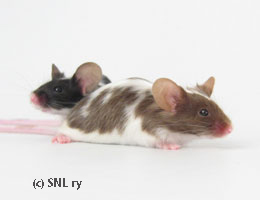
a/a B/* s/s & a/a b/b s/s |
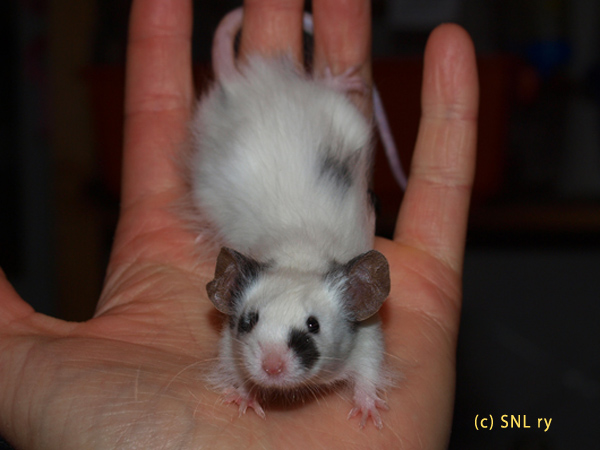
Black broken, a/a B/* s/s |

Black dutch, a/a B/* s/s (?) |
These spotted varieties aren't very easy to breed, although spotted mice are rather easily found in pet shops around the world. The diffuculties are brought in because the gene and the markings it produces are greatly affected by the modifiers. Without the presence of right modifiers, a ss mouse may have only a few white spots on the belly, feet and forehead. In the other extreme end - these mice may be almost totally unpigmented! All in all, the mouse's belly has more white than the top side. As the mouse becomes less pigmented, the last areas to lose pigmentation are the eyes, cheeks, ears and haunches.
The s-gene has been reported of being associated with megacolon and there have been reports of some 10% in some laboratory strains of s/s mice having this condition.
1.1. The Dutch mouse
It is argued, that the Dutch markings in mice would actually not be caused by the recessive white spotting gene, but some kind of gene of its own. This is backed up with the notion that if you cross Dutch with self, you will return to (poor) Dutch after only one intermediate generation.
2. Rumpwhite Rw
Rumpwhite is caused by a lethal dominant gene Rw, thus all rumpwhites are heterozygous and breeding rumpwhite to rumpwhite will cause 25% smaller than average litters. The gene being dominant, it is fairly easy to introduce this marking into new colours. However, these mice usually have only white tail and small patch of white in the rump. It takes quite a lot of selective breeding to establish the markings required by standards. Therefore, rumpwhite isn't one of the easiest varieties to breed and the breeder does need quite a lot of patience and a number of breeding stock.
2.1. Interaction between Rw and other marked genes
When Rw is combined with piebald (recessive white spotting), the mice have pigmented hairs on their heads and shoulders, but little elsewhere. With belted (bt/bt) the mice resemble rumpwhite, but with quite uneven demarcation lines. With banded (Wsh) to rumpwhite matings there have been capped-like mice, as well as mice who resemble the rat variety bareback.
3. Brindle (UK) Mobr
The effect of this gene is sex-related. The brindle males are almost white with sooty tips (they look like siameses) and the coat is curly. This gene is usually lethal in males, and they usually die at 10 - 14 days of age. Sometimes, some will survive and live to be adults. However, these mice suffer form neurological conditions, which makes them "wobble" and their hind legs to clasp each others when held by the tail. If a brindle male is mated to brindle female, the resulting heterozygous females resemble the homozygous males.
In females, this gene causes brindling pattern in the coat. Some are lighter, some darker and they tend to get darker with age. The pattern can be selectively bred to show better brindling. There have been reports of also females being "wobblers" in brindle.
4. Belted bt
Belted is an older variety than the banded and originated from a lab in 1940's. This recessive gene causes a thin belt around the mouse's waist when homozygous. At the arrival of the banded mouse, the Belted was becoming rare and there was some confusion among the mouse fanciers. Nowadays, Belted isn't fully standardized anywhere to my knowledge. However, some Belted mice appear every now and then. If you have mated two self mice together and get mice with a thin belt in the litter, you most probably have a Belted in your hands!
(Just a slight note: some genetically banded mice may show only a small white belly spot or even just a couple of white hairs and when mated to a self produce clearly banded mice!)
5. W Locus
W-series, or Dominant Spotting.
W-series genes within the mouse fancy include W, Wsh and Wbd. There are quite likely some other forms of W around, like Wv, viable dominant spotting.
5.1. Dominant white spotting W
The dominant white spotting gene W is responsible for variegated (and possibly one of the newer varieties, Berkshire). Genetics know the gene as "kit oncogene W" or KitW and there are several mutations of it. This gene is also called lethal white spotting, because the combination W/W is lethal. These mice are black eyed whites, anemic and die before two weeks of age. The main effect of this gene is small, ragged edged splashes of colour on a white background. Unlike the name implies, W isn't truly dominant, but semidominant. This means that a W/w (or to put it correctly, W/+) mouse can be variegated - but it can also be non-marked, or even completely white. W is a tricky gene to work with, it may act as a recessive and may not always produce spotted mice.
This variety is also highly dependent on modifiers, which may be part of the k complex. Just like the even and broken marked, the variegated mouse takes a lot of patience - and mice - to breed into perfection.
5.1.1. Interaction between W and s
When a mouse has both Ww/* and s/s, it is either entirely white with black eyes or has small pigmented areas in the region of the ears and/or the haunches.
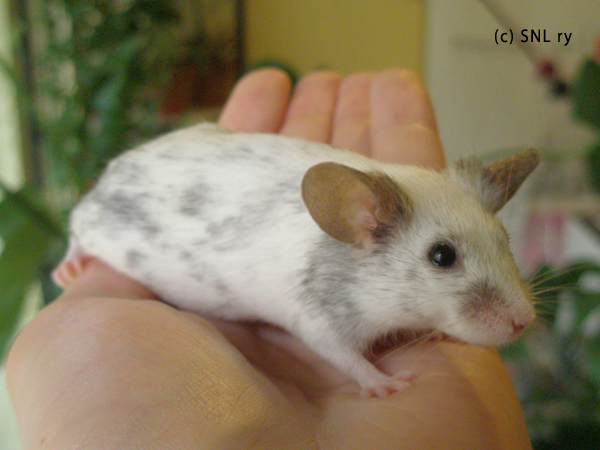
Black variegated, a/a B/* W/w |
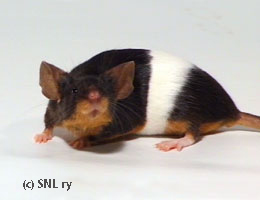
Black tan banded, |
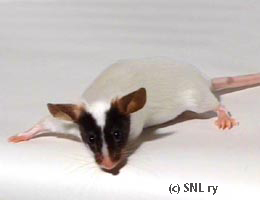
Black capped, a/a B/* Wbd/Wsh |
5.2. Wsh, Banded
The major banding gene mouse fanciers work with is actually gene called "sash", not "banded". The latter does exist and is deal with in the next chapter. The banded gene sash, Wsh, is rather new to the mouse fancy. It was first reported in a lab (it was a spontaneous mutation) in 1978 and in the 1980's it was introduced to the mouse fancy. This dominant gene produces a white band around the mouse's waist. When heterozygous, the mouse has this typical banded appearance, which can vary from tiny trace of white to huge wide band. When homozygous, the band widens to leave colour only in the head and rump. These latter kind of mice can be selectively bred to lose all pigment into black eyed whites. Banded is easy to introduce into new colours and coat types as such, but of course it will need a lot of selective breeding to get into perfection. Other marked genes are a big no-no for banded breeding, especially minor genes causing tail and head spots.
When breeding bandeds, one should never mix in other marked variety genes. White spotting genes are an especially unwanted lot, as well as minor genes causing head and tail spots.
5.3. Wbd, Capped
The mouse variety capped may simply be something you can breed out of your ordinary everyday bandeds. On the othar hand, it may also be the result of a specific gene. The following is my theory on the subject, backed by more than a decade of breeding cappeds, as well as what genetics say about the effects of the banded gene and interaction between sash and banded. The descriptions available in scientific sources fit quite well my own findings. The major difference between sash and banded mice (both homozygotes and heterozygotes) is the amount of white on Wbd mice and the fact that there are always anaemic young in capped litters (which does not occur with Wsh mice).
Banded is a semidominant gene, causing variable phenotypes. With capped x capped matings, the litter size is usually somewhat smaller than with other varieties and the number of young reaching adulthood noticeably smaller. Some of the young are aneamic and some of them perish around 2-5 weeks of age. Those who survive, grow up to be perfectly normal mice. The whiter the young, the more likely it is to perish.
